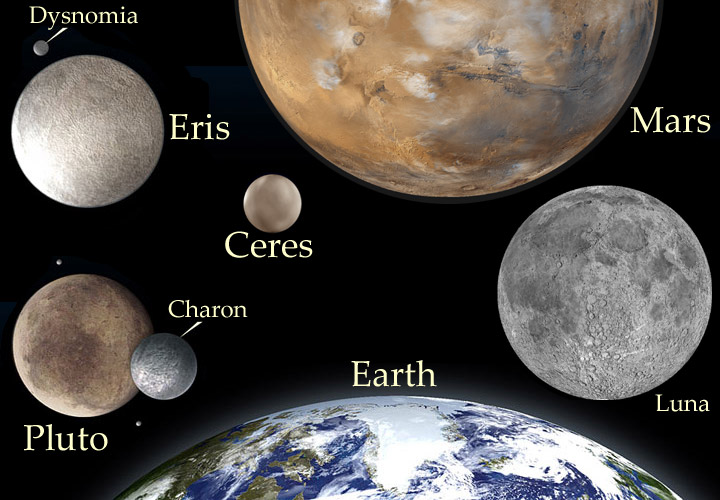Here is a list of the symbols of the Celestial Bodies:
Here are some notes that we had discussed:
All the terrestrial planets are: Mercury, Venus, Earth, and Mars
All the gas planets are: Jupiter, Saturn, Neptune, and Uranus
The Sun has the longest revolution in our solar system
Mercury is the smallest planet
Venus is the biggest object we see in the sky from Earth (with the exception of the Sun and the Moon) because the atmosphere bounces off the light from the Sun
Venus is a good example of global warming
Venus rotates clockwise while all the other planets rotate counter clock wise
The Earth’s atmosphere is made of oxygen, hydrogen, carbon dioxide, nitrogen, H2O, O3, and Methane
The Earth’s land is made of: basalt, and iron
Saturn is the least dense planet in our galaxy
Galileo who discovered the rings of Saturn thought that they were the planets ears
Cassini which is a probe launched on October 15th, 1997 
is still orbiting around Saturn and taking the best pictures
ever taken of Saturn
Saturn has 62 moons however 53 moons have been named until now
Jupiter is the biggest planet
Jupiter has the 4 biggest moons
The first name of Uranus was called Georgium Sidus
(The Georgian Planet) in the honor of the British King; George III
Uranus has no magnetic field
The Methane in the atmosphere makes Neptune and Uranus blue
Eris is the biggest dwarf planet in our solar system
Haumea is the smallest dwarf planet in our solar system
Eris is the reason why Pluto isn’t a planet anymore because once they found Eris they knew it wasn’t supposed to be a planet and then they saw the similarities between Eris and Pluto so they decided that they are both dwarf planets
Three reasons why dwarf planets are dwarf planets:
1. Clear orbital path around the sun day do not exist
2. They are too small
3. The orbital paths are not on the same place as the planets
Videos (Just Click on the title):
Don't forget to check moodle for homework!!!!
Next Scribe will be by: Jacob
Don't forget to comment!!!!




Gregor, Awesome post. But you made one mistake. The summer and winter poles of Uranus are constantly in Summer or Winter, not 42 years of each. Otherwise awesome post, the pictures are helpful. It could use a little more color though.
ReplyDeleteThanks.
Great job Gregor. You clearly described what was reviewed in class on Friday and used supportive pictures and diagrams to take it further. Your scribe post is quite organized and insightful as it let me have a better understanding of the class. I do, although, agree with Aidan as the poles of Uranus are not only 42 years of Summer or Winter but are endlessly either Summer or Winter ( planet revolves like a barrel). I also liked it how you demonstrated the symbols of the celestial bodies and thought it was helpful to many of us. All in all, Awesome job!
ReplyDeleteGregor, you made a wonderful post! You have covered all the facts that were covered in class. The pictures and diagrams were wondeful as they really helped me understand about space, the planets, and parts of the Cassini probe. I agree with Emma and Aidan that the poles of Uranus are not only 42 years of summer and winter, but that it is always like that. Overall, you poost is very well thought out and you did a wonderful job.
ReplyDeleteGregor
ReplyDeleteGood Job !
This post was really clear and explained everything that we spoke about in class. You also included pictures with information which was great. However like Arnie, Emma and Aidan said the poles are noot only 42 years of winter and summer, they never end being winter and summer. I think the font, the visual and everything were really easy to read and see. Overall Good Job
Kamil (minor)
Nice job on your post. You included a lot of good pictures. Nice job that you posted the Celestial symbols for every celestial body, this would actually help us with the test we are going to have. However, I need to agree with Aidan, Kamil, Arnie and Emma. Unarus' poles have constant winter and summer on each pole for 42 years. But you did a great job on your post overall.
ReplyDeleteGregor - Your post looks very good and your hyperlinks are extremely helpful. You have a good list of things we discussed in class, and I am sure that will help your classmates, especially those who were absent. I do agree with some of the comments above about the seasons on Uranus. Remember, the seasons are due to the almost horizontal tilt of Uranus' axis. Spelling and grammar are okay, but in places you have some problems, plus don't forget to use punctuation. Overall, nice work :)
ReplyDelete